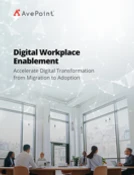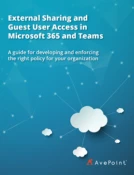One Dream, One Team, One Collaboration Environment
How to launch a stunningly successful Microsoft 365 migration in 5 simple steps

Event Information
- 1 Hour
Expert Speakers

Senior Vice President, ACS & Product Strategy, AvePoint
Consolidate Your Collaboration
There are a variety of ways collaboration silos happen.
For some organizations, it's the result of merger and acquisition activity, “legalized” shadow IT, or different business units choosing their own collaboration systems. For others, offices in different geographies may have grown up with different tenants or data has naturally diffused across systems over time.
But for all organizations, having data in multiple collaboration environments is bad news because it:
- Hampers internal communication and productivity
- Prevents the formation of a cohesive organizational culture that can help retain talent
- Increases license and maintenance costs as well as the risk of data leaks
Learn how to consolidate your collaboration environment to maintain productivity, compliance, and security in one Microsoft 365 tenant in just 5 simple steps.
You will learn:
Discovery
Discover the best ways to understand licenses, content, and workflows that will need to move or be recreated in the target tenant along with the limitations that exist with different migration approaches. Learn how to leverage pre-migration data scans to estimate project scope and timeline.
Plan
Learn best practices for determining the ideal Microsoft Teams and overall collaboration architecture for your organization. How to identify and understand policy decisions that will need to be made regarding governance, data protection, and compliance. How to convince data hoarders across the business to let go of ROT (redundant, obsolete, trivial data). How to develop a schedule and plan for minimizing business disruption. Tips for piloting your migration to identify unforeseen pitfalls.
Communicate
How to prepare and train your users to be ready for the new environment.
Move
Steps for validating all items have migrated and launching incremental migrations as necessary. How to evaluate and mitigate any exceptions.
Post Migration
Best practices for decommissioning and transitioning from the old environment. How to execute ongoing user training, change management and user satisfaction surveys.
More Similar Resources to Explore

Digital Workplace Enablement

Watch Us Lose Data: Power Platform Edition

A Masterclass in Teams Tenant to Tenant Migration
